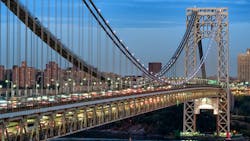As Americans across the country returned to more regular travel in 2021, roads, bridges, and highways saw increased congestion and reduced speeds. But where did drivers see the biggest traffic bottlenecks?
The American Transportation Research Institute (ATRI) released its annual list of the most congested bottlenecks for trucks in the U.S, revealing that for the fourth consecutive year, the New Jersey side of the George Washington Bridge, where I-95 and State Route 4 intersect in Fort Lee tops the list.
According to ATRI, the 2022 Top Truck Bottleneck List analyzed over 300 locations on the national highway system in 2021 to measure the level of truck-involved congestion. The analysis, based on truck GPS data from over one million freight trucks, uses several customized software applications and analysis methods, along with terabytes of data from trucking operations to produce a congestion impact ranking for each location. Click here for a full description of ATRI's research methodology.
ICYMI: What were the worst bottlenecks in 2021?
“ATRI’s bottleneck list is a roadmap for federal and state administrators responsible for prioritizing infrastructure investments throughout the country,” said Chris Spear, American Trucking Associations president and CEO. “Every year, ATRI’s list highlights the dire needs for modernizing and improving our roads and bridges. We have seen, most recently in Pittsburgh, that the cost of doing nothing could also cost lives. It’s time to fund these projects and get our supply chains moving again.”
ATRI’s analysis found that as Americans returned to regular travel following the heights of the COVID-19 pandemic in 2020—and consumer demand for goods and services continued to grow—traffic levels rebounded. Overall travel speeds were reduced, causing increased supply chain bottlenecks. Average rush hour truck speeds were 38.6 MPH, down more than 11% from the previous year. Check out the time-lapse videos below to see how each bottleneck develops.
1. Fort Lee, New Jersey: I-95 at SR 4
2. Cincinnati: I-71 at I-75
3. Houston: I-45 at I-69/US 59
4. Atlanta: I-285 at I-85 (North)
5. Atlanta: I-20 at I-285 (West)
6. Chicago: I-290 at I-90/I-94
7. Los Angeles: SR 60 at SR 57
8. Dallas: I-45 at I-30
9. San Bernardino, California: I-10 at I-15
10. Chattanooga, Tennessee: I-75 at I-24
About the Author
FleetOwner Staff
Our Editorial Team
Kevin Jones, Editorial Director, Commercial Vehicle Group
Josh Fisher, Editor-in-Chief
Jade Brasher, Senior Editor
Jeremy Wolfe, Editor
Jenna Hume, Digital Editor
Eric Van Egeren, Art Director
